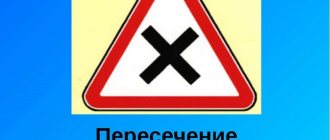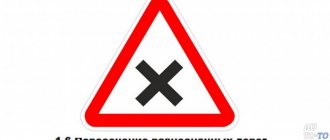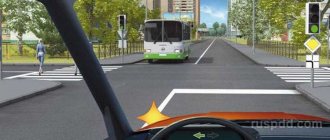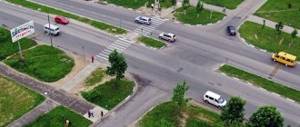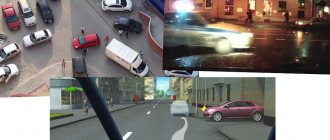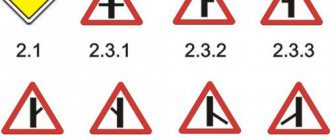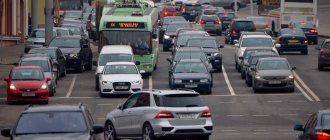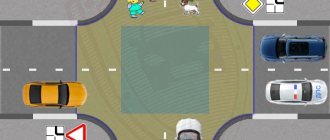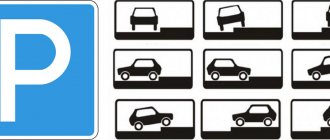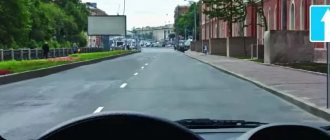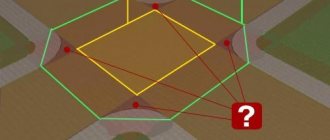Good afternoon, dear reader.
In the next article in the series “Rules for driving through intersections,” you will learn about the rules of the road that apply to uncontrolled equivalent intersections .
It is quite difficult to find such an intersection in a populated area. However, outside the city, equivalent intersections have become widespread, so every driver needs to clearly know how such intersections can be passed without violating traffic regulations.
I remind you that the driver must determine the type of intersection before the car enters that intersection. Previous articles in the series cover intersections:
- with a traffic controller;
- with traffic lights;
- unequal.
At first glance, it seems that the rules for driving through intersections are unreasonably complex, since dozens of different situations are possible. In fact, everything is quite simple, and if you spend a few minutes studying the previous articles in the series, you will not have any problems.
As for uncontrolled equivalent intersections, only a couple of points of traffic rules apply to them, and therefore they should not cause any difficulties. These rules will be discussed below:
- Signs of an equivalent intersection.
- Order of movement.
- Unsolvable situation at the crossroads.
Signs of an equivalent intersection
An intersection is equivalent if simultaneously met:
- no traffic lights or traffic controller;
- no priority signs (main road, give way, etc.);
- both intersecting roads have the same surface (hard or dirt).
Additionally, to indicate equivalence, road sign 1.6 “Equivalent intersection” can be used:
Note. The number of lanes and carriageways on roads does not affect the type of intersection.
T-junction
The main difference between a T-intersection and other types of similar sections is that there are fewer roads. The rules for driving through such intersections depend on what maneuver and in what direction the driver plans to make.
When driving through T-shaped intersections of equivalent roads, you must follow the rules:
- Compliance with the rule of skipping interference on the right.
- Accuracy in driving and attentiveness to the situation.
- Performing a maneuver at low speed to avoid unpleasant situations.
It is important to remember that an equivalent intersection is a place with a high level of danger and it is on such sections of the road that the largest number of accidents occur. When a driver does not act according to traffic rules, but based on his own desires, the risk of unpleasant situations increases several times.
Driving through intersections by such motorists is fraught with consequences for other road users that none of them can foresee.
By following simple rules you can minimize risks. The main thing when driving through an equivalent intersection is not just to rely on your own confidence in the correctness of your own skills and knowledge, but to be as careful as possible in your actions. This is the only way to prevent unpleasant situations from arising.
Tags: road means unequal
- Related Posts
- Distance between cars according to traffic rules in 2021
- Department of organization of compensation payments RSA
- What to do in case of a car accident
« Previous entry
Order of movement
Driving through equivalent intersections is regulated by two points of the traffic rules (13.11 and 13.12), the first of which applies to all maneuvers at the intersection, and the second - only to turning left and making a U-turn:
13.11. At the intersection of equivalent roads, with the exception of the case provided for in paragraph 13.111 of the Rules, the driver of a trackless vehicle is obliged to give way to vehicles approaching from the right. Tram drivers should follow the same rule among themselves.
13.12. When turning left or making a U-turn, the driver of a trackless vehicle is obliged to give way to vehicles moving on an equivalent road from the opposite direction straight or to the right. Tram drivers should follow the same rule among themselves.
Right turn
When making a right turn, the trajectory of the white car does not intersect with the trajectories of other cars, so this maneuver can be performed regardless of whether vehicles are approaching from other directions.
Go straight
When driving straight, the trajectory of the white car intersects with the trajectories of other cars. In this case, you should give way to an orange car that is approaching the intersection on the right.
Turn left or make a U-turn
Let me remind you that when making a left turn or a U-turn at an equivalent intersection, in addition to paragraph 13.11 of the rules, paragraph 13.12 also applies. Therefore, it is necessary to give way to both cars approaching from the right (regardless of which direction they are traveling) and to cars that are coming towards you and making a right turn or continuing to drive straight. Those. You should give way to both the orange and blue cars.
Please note that the trajectory of your car will not always intersect with the trajectories of the vehicles listed above, so not all cars need to give way.
For example, if multi-lane roads intersect at an intersection, then cars will be able to pass each other and their trajectories will not intersect.
Rules for driving through an intersection
When you are driving along, say, a main road, there should be no doubt about who should pass. In addition, as a rule, on all city roads there are signs that clearly and clearly paint a picture of which of the road users has the right of way. If you meet equivalent roads on your way, the question does not arise: who goes first, since everyone is in the same conditions. It is important to understand that you will not have to understand the rules of time; you need to make a decision instantly. First of all, if you encounter such a road on your way, you need to reduce your speed. Before crossing similar roads, as a rule, a special road sign is installed - this will be a signal that you need to slow down. You cannot know what awaits you around the corner.
In such a situation, you need to quickly make a decision and remember the three main rules for driving equivalent roads:
- First of all, vehicles that move on rails pass; this also applies to regular buses.
- All cars that are on our right have priority and arrive first.
- First of all, you need to give way to those driving in a straight line, then you need to give way to those turning right.
Basic driver actions when turning right
This maneuver will not be difficult to perform. It is necessary to assess the situation, check whether there are pedestrians or rail vehicles on the road, then turn right in the direction of your movement. Also, it is very important to remember that before turning, you can change lanes to the far right lane, otherwise you may remain in the other lane and not have time to change lanes. If this is not done in advance, the driver will find himself in an awkward situation, since he will not be able to continue driving and will have to wait for the resulting window. If there is free space, you need to turn off or try to take a position on the edge of the road for further movement.
How to turn left and turn around at an intersection
Very often, such a turn makes novice drivers panic. There are no regulatory devices on such roads, and it is completely unclear what to do. In such a situation, you need to pull yourself together and concentrate. First of all, you need to turn on the turn signal in order to indicate your intention to perform the maneuver. Other road users will also see this and take appropriate action. It is also necessary to move the car closer to the center of the road, and if there are no obstacles, it is necessary to make a turn or turn around.
Traffic rules when driving straight
In such a situation, all actions are extremely simple, since there is no need to turn anywhere and there is no need to change lanes either. You just need to drive straight, and you will need to carefully monitor the traffic situation. If this is required, then skip all vehicles that are an obstacle on the right. In this case, only the right-hand side rule works. It is necessary to give way to all vehicles turning right, moving in the outer lane of the roadway and wishing to turn left, as well as to those cars approaching from around the corner with the right turn signal on.
In such a situation, the responsibility for determining how to drive lies entirely with the driver. It is necessary to be extremely careful and concentrated on the road, since accidents very often occur on such roads.
How to identify a main road without signs
Arthur, one is the main one, the other is secondary. . these are unequal) it can be an asphalt road in relation to a dirt road, or a road with a “main road” sign in relation to a road with a “give way” sign. equivalent - these are roads at the intersection of which the order of travel is determined either by the traffic controller or by the drivers themselves according to the rule “interference on the right”
Gennady 1. Equal roads - roads with the same surface Valery without priority signs Evgeny. 2. Unequal roads - with different surfaces Denis will always be the main one in relation to the dirt road). Unequal roads are also identified by priority signs: “Give way” means the road is of secondary importance. “Main road” is the main road, you have priority.
Movement along the "main"
How to determine which road a car is traveling on? In this case, it is worth turning to the definition. The main road, in accordance with clause 1.2 of the traffic rules, is indicated by signs 5.1, , 2.1 in relation to the adjacent one or has a hard surface (stone material, cement and asphalt concrete, etc.). It also includes any route relative to exits from adjacent territories. In some cases, the section of the secondary road that is located in front of the intersection has a hard surface. However, this does not make it equal to the one it intersects.
Driving school online
How do we understand this – an equivalent road at the crossroads of unequal roads?! The rules mean the following: both you and the tram are on the main road. Or both, you and the tram - on a secondary road. In this case, the tram moves either in the opposite direction or in the same direction.
What is characteristic of the intersection of unequal roads? Firstly, this is necessarily an unregulated intersection. There are no traffic controllers or traffic lights here. Or there are traffic lights, but they do not work or are switched to flashing yellow mode. And, secondly, one road is the main one, and the others (no matter how many there are) are secondary.
12 Jul 2021 1455
As the traffic rules state, today there are several ways to regulate intersections, these are:
- Traffic light;
- Traffic signs;
- A traffic police and traffic police officer, that is, a traffic controller;
In addition to regulating intersections with the intervention of third parties or special equipment (signs or traffic lights), there are additional rules that, in the absence of all components, can resolve the dispute.
Today it is:
- Uneven road surfaces. The surface of the road determines the role of traffic at the intersection along it. That is, if the intersection is the intersection of a gravel and asphalt surface. The road with an asphalt surface is considered the main one.
- Right hand rule. If the traffic of the intersection is not regulated in any way and the road surface is equal, then we are guided by the “obstacle on the right.” That is, all those vehicles that are on the right have a primary role, which means that the driver on the left gives way.
According to the traffic rules, an intersection where the traffic order is not regulated by traffic lights, traffic police officers, that is, a traffic controller, signs, as well as an intersection where the roads have the same surface, is an unregulated intersection of equivalent roads.
From here we get that an equivalent road is a section of the road that is not regulated, either by signs or devices, where there is no traffic controller. At the same time, the road coverage is equal. A crossroads of equivalent roads is an intersection of streets where the directions are equal in meaning.
Then, as the traffic rules say, the driver must follow the right-hand rule. That is, let everyone who is on the right side of the intersection pass. In turn, the driver who moves along the intersection on the right side has the main road and should not allow vehicles on his left to pass.
Will I have to give way to pedestrians?
An ambiguous situation may arise when, in addition to cars, people take part in the movement. It is necessary to give way to pedestrians at an intersection when there is a crossing there. The priority here is undeniable. As with a working traffic light, it will indicate with a green signal who should move and who should wait.
Everything looks a little different if there is no zebra crossing, the area where the tracks converge is unregulated, but there is also no symbol prohibiting crossing the roadway in this place. Paragraph 13.1 of the traffic rules states:
When turning right or left, the driver is obliged to give way to pedestrians crossing the carriageway onto which he is turning, as well as to cyclists crossing it on a bicycle path.
But there is also section 4.5 of the Rules:
When crossing a roadway outside a pedestrian crossing, pedestrians must, in addition, not interfere with the movement of vehicles and exit from behind a standing vehicle or other obstacle that limits visibility without making sure that there are no approaching vehicles.
That is, the motorist must yield again. But the pedestrian is also obliged to let him turn if he has already begun the maneuver, and not rush from the sidewalk onto the roadway to prove his advantage.
More on AutoLex.Net:
Correct interpretation of traffic light signals from traffic regulations
Equal and unequal in traffic rules
Equivalent and unequal intersections are separated in the “Rules...”, although the document does not contain explanations of both terms. But there is the concept of “main road”:
Main road" - a road marked with signs 2.1, - or 5.1, in relation to the one being crossed (adjacent), or a road with a hard surface (asphalt and cement concrete, stone materials, etc.) in relation to a dirt road, or any road in relation to travel from surrounding areas. The presence of a paved section on a minor road immediately before the intersection does not make it equal in importance to the one it intersects.
If there is one, the direction that crosses it is secondary. And the intersection is unequal. The absence of such a division of converging paths changes its status to the opposite.
Among the main terms used in traffic rules, there is also the following:
Give way (do not interfere)" is a requirement that means that a road user must not start, resume or continue moving, or carry out any maneuver if this may force other road users who have priority over him to change the direction of movement. or speed.
It relates both to unequal intersections of paths and to those where roads with the same status converge. But the requirement in both cases is fulfilled according to different rules.
In the very definition of an intersection there is no explanation of what they are. But this does not negate the differences.
